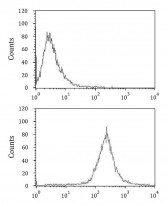ARG54829
anti-BMPR1A antibody
anti-BMPR1A antibody for Flow cytometry,Western blot and Human
Cell Biology and Cellular Response antibody; Developmental Biology antibody; Metabolism antibody; Signaling Transduction antibody
Overview
| Product Description | Rabbit Polyclonal antibody recognizes BMPR1A |
|---|---|
| Tested Reactivity | Hu |
| Tested Application | FACS, WB |
| Host | Rabbit |
| Clonality | Polyclonal |
| Isotype | IgG |
| Target Name | BMPR1A |
| Antigen Species | Human |
| Immunogen | KLH-conjugated synthetic peptide corresponding to aa. 1-30 (N-terminus) of Human BMPR1A. |
| Conjugation | Un-conjugated |
| Alternate Names | CD292; CD antigen CD292; ALK3; ACVRLK3; ALK-3; EC 2.7.11.30; Activin receptor-like kinase 3; 10q23del; Serine/threonine-protein kinase receptor R5; BMPR-1A; BMP type-1A receptor; SKR5; Bone morphogenetic protein receptor type-1A |
Application Instructions
| Application Suggestion |
|
||||||
|---|---|---|---|---|---|---|---|
| Application Note | * The dilutions indicate recommended starting dilutions and the optimal dilutions or concentrations should be determined by the scientist. | ||||||
| Positive Control | Human liver |
Properties
| Form | Liquid |
|---|---|
| Purification | Purification with Protein G. |
| Buffer | PBS and 0.09% (W/V) Sodium azide |
| Preservative | 0.09% (W/V) Sodium azide |
| Storage Instruction | For continuous use, store undiluted antibody at 2-8°C for up to a week. For long-term storage, aliquot and store at -20°C or below. Storage in frost free freezers is not recommended. Avoid repeated freeze/thaw cycles. Suggest spin the vial prior to opening. The antibody solution should be gently mixed before use. |
| Note | For laboratory research only, not for drug, diagnostic or other use. |
Bioinformation
| Database Links |
Swiss-port # P36894 Human Bone morphogenetic protein receptor type-1A |
|---|---|
| Gene Symbol | BMPR1A |
| Gene Full Name | bone morphogenetic protein receptor, type IA |
| Background | The bone morphogenetic protein (BMP) receptors are a family of transmembrane serine/threonine kinases that include the type I receptors BMPR1A and BMPR1B and the type II receptor BMPR2. These receptors are also closely related to the activin receptors, ACVR1 and ACVR2. The ligands of these receptors are members of the TGF-beta superfamily. TGF-betas and activins transduce their signals through the formation of heteromeric complexes with 2 different types of serine (threonine) kinase receptors: type I receptors of about 50-55 kD and type II receptors of about 70-80 kD. Type II receptors bind ligands in the absence of type I receptors, but they require their respective type I receptors for signaling, whereas type I receptors require their respective type II receptors for ligand binding. [provided by RefSeq, Jul 2008] |
| Function | On ligand binding, forms a receptor complex consisting of two type II and two type I transmembrane serine/threonine kinases. Type II receptors phosphorylate and activate type I receptors which autophosphorylate, then bind and activate SMAD transcriptional regulators. Receptor for BMP-2 and BMP-4. Positively regulates chondrocyte differentiation through GDF5 interaction (By similarity). [UniProt] |
| Cellular Localization | Membrane; Single-pass type I membrane protein |
| Research Area | Cell Biology and Cellular Response antibody; Developmental Biology antibody; Metabolism antibody; Signaling Transduction antibody |
| Calculated MW | 60 kDa |
Images (2) Click the Picture to Zoom In
-
ARG54829 anti-BMPR1A antibody WB image
Western blot: 35 µg of Human liver lysate stained with ARG54829 anti-BMPR1A antibody at 1:1000 dilution.
-
ARG54829 anti-BMPR1A antibody FACS image
Flow Cytometry: WiDr cells stained with ARG54829 anti-BMPR1A antibody (bottom histogram) or without primary antibody control (top histogram), followed by incubation with FITC labelled secondary antibody.







